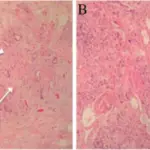Hereditary hemorrhagic telangiectasia is a rare condition that is characterized by numerous arteriovenous malformations.
What is the Pathology of Hereditary Hemorrhagic Telangiectasia?
The pathology of hereditary hemorrhagic telangiectasia is:
-Etiology: The cause of hereditary hemorrhagic telangiectasia is autosomal dominant syndrome that is instigated by gene mutations encoding components of the TGF-β signaling pathway of endothelial cells.
-Genes involved: ACVRL1, ENG, SMAD4.
-Pathogenesis: The sequence of events that lead to hereditary hemorrhagic telangiectasia are the result of defects in a TGF-β superfamily receptor. Advances of atypical vasculature cause clinical manifestation.
-Morphology: Numerous arteriovenous malformations lacking prevailing capillaries, resulting in arteries and veins direct connections.
-Histology: Numerous arteriovenous malformations lacking prevailing capillaries, resulting in arteries and veins direct connections.
How does Hereditary Hemorrhagic Telangiectasia Present?
Patients with hereditary hemorrhagic telangiectasia typically common in males over 15 years old. The symptoms, features, and clinical findings associated with hereditary hemorrhagic telangiectasia include epistaxis, anemia, telangiectases, and pulmonary hypertension.
How is Hereditary Hemorrhagic Telangiectasia Diagnosed?
Hereditary hemorrhagic telangiectasia is diagnosed through CBC count, coagulation studies, genetic tests, oximetry, and ABGs. Imaging- radiography, helical CT, MRI, angiography.
How is Hereditary Hemorrhagic Telangiectasia Treated?
Hereditary hemorrhagic telangiectasia is treated surgical and medical care of the symptoms.
What is the Prognosis of Hereditary Hemorrhagic Telangiectasia?
The prognosis of hereditary hemorrhagic telangiectasia is fair.


